Common menu bar links
Breadcrumb Trail
ARCHIVED - Veterans Affairs Canada - Report
 This page has been archived.
This page has been archived.
Archived Content
Information identified as archived on the Web is for reference, research or recordkeeping purposes. It has not been altered or updated after the date of archiving. Web pages that are archived on the Web are not subject to the Government of Canada Web Standards. As per the Communications Policy of the Government of Canada, you can request alternate formats on the "Contact Us" page.
Section II - Analysis of Program Activities by Strategic Outcome(s)
This section provides detailed information about the Department’s program activities and how they support the achievement of our strategic outcomes. An overview of planned spending, performance information and key planning highlights can be found for each program activity.
Strategic Outcome #1 - Financial, physical and mental well being of eligible Veterans
Program Activities:
- Disability and Death Compensation
- Financial Support
- Health Care Program and Re-establishment Services
Departmental Spending Trend ($ millions)
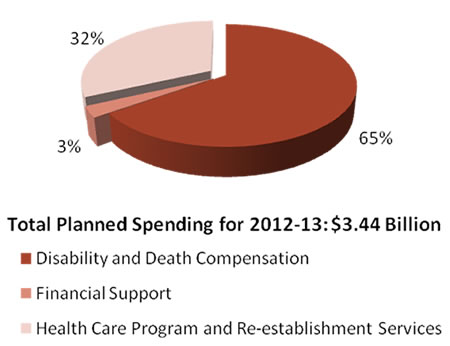
Financial Resources ($ millions)
| 2012-13 | 2013-14 | 2014-15 |
|---|---|---|
| 3,444.3 | 3,204.1 | 3,207.6 |
Human Resources (FTEs)
| 2012-13 | 2013-14 | 2014-15 |
|---|---|---|
| 2,654 | 2,510 | 2,291 |
Veterans Affairs Canada assists and helps the men and women who have proudly served Canada in times of war, conflict and peace.
To ensure their continued well-being after release, VAC provides access to a full range of programs and services designed to meet their medical, psycho-social, vocational and financial needs. These programs includes: Disability Benefits, Financial Benefits, Health Care Benefits, the Veterans Independence Program, Rehabilitation Services and Vocational Assistance.
The Department contributes to the well-being of Veterans by:
- Maintaining departmental programs and services that respond to the needs of Veterans and their families;
- Conducting and partnering on research projects that support advancement in areas such as mental health;
- Partnering with the Canadian Forces on various initiatives such as integrated personnel support centres and other initiatives that support transition from military to civilian life; and
- Strengthening outreach, engagement and consultation efforts to better serve CF members, Veterans, Veterans’ organizations and other stakeholders.
SO1 Planning Highlights
- Re-engineering policies and processes to reduce complexity and support better decision making;
- Reducing the time it takes to render disability benefit decisions;
- Providing Veterans with easier and faster access to needed health benefits;
- Consulting with members of the Canadian Forces and their families to better understand and respond to their needs;
- Revising our mental health strategy to better meet the needs of Veterans and their families;
- Enhancing military and Veteran health capacity through strong partnerships; and
- Enhancing case management to better support individuals with complex needs by
- clarifying the roles and responsibilities of client service team members;
- implementing workload intensity tools;
- establishing national access to case management consultants;
- developing a national case-management learning strategy; and
- establishing competency profiles for key client service team members.
Program Activity 1.1 - Disability and Death Compensation
Sub Activities:
- Disability Pension Program
- Disability Award Program
Description
This program supports eligible Veterans, Canadian Forces Veterans and members, survivors, spouses/common-law partners, dependents and civilians whose lives have been permanently affected as a result of service to their country.
In recognition of the effects of service-related disabilities or death, compensation is provided in the form of monthly disability pensions, lump-sum disability awards and monthly allowances. The amount of benefit awarded is dependent on the severity of the disability and its impact on daily functioning.
This program activity is delivered through grants.
PA 1.1 Snapshot
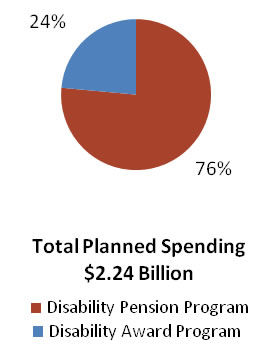
Human Resources (FTEs)
| 2012-13 | 2013-14 | 2014-15 |
|---|---|---|
| 824 | 759 | 661 |
Human Resources Planned Spending ($ millions)
| 2012-13 | 2013-14 | 2014-15 |
|---|---|---|
| 2,244.5 | 1,962.4 | 1,960.5 |
| Program Activity Expected Results | Performance Indicators | Targets |
|---|---|---|
| Eligible Veterans feel the effects of their service-related disability have been recognized. | Percentage of eligible Veterans who feel the disability benefits they have received from Veterans Affairs Canada has recognized their service-related disability. | 65% |
| Eligible Veterans receive compensation in recognition of the effects of service-related disabilities or death. | Total number of recipients of disability and/or death compensation and the dollar value of the compensation. | As Required |
Planning Highlights
Redesigning the Disability First Application Process
VAC will complete a business process redesign of the first application process for disability benefits. This will result in a streamlined process that maximizes the use of technology; that provides more efficient and customized service for Veterans and their families; and that supports employees to better to do their jobs by equipping them with current information and appropriate tools.
Providing faster access to disability benefits
VAC will work to better support the needs of Veterans by reducing internal complexity, simplifying the application process and providing online tools in order to reduce the time required to render a decision for first applications from 16 to 12 weeks.
Improving disability letters
VAC will work to improve the disability letters that are sent to Veterans and other applicants by simplifying their wording and improving their clarity.
Policy renewal
VAC will work to simplify its existing policies and processes to support better decision making and improve the quality and timeliness of service to Veterans and other individuals.
Scientific Advisory Committee
In December 2011, Minister Blaney announced a new Scientific Advisory Committee, consisting of internationally recognised experts, to provide advice on Veterans health issues. It will be important to receive the findings of this committee and to monitor other research so VAC can respond to the emerging needs of Veterans.
Program Activity 1.2 - Financial Support Program
Sub Activities:
- Financial Benefits
- War Veterans Allowance
Description
This program provides income support to eligible Veterans, qualified civilians and their survivors. The intent of the support is to ensure that recipients have income which is adequate to meet their basic needs.
In recognition of the effects of war time service in the case of war service Veterans, income support may be paid in the form of a monthly War Veterans Allowance. The program also provides economic support to Canadian Forces Veterans, survivors, spouses/common-law partners and dependents for the economic impact that a career ending and/or service-related injury or death can have on a Veteran ‘s ability to earn income, advance in a career or save for retirement.
Compensation is provided in the form of a monthly income support payment. A lump-sum supplementary retirement benefit is available to those who are totally and permanently incapacitated. There is also an allowance available for those with severe and permanent impairments.
This program activity is delivered through grants.
PA 1.2 Snapshot
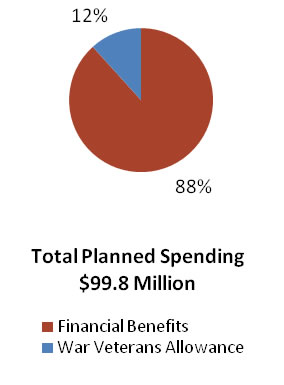
Human Resources (FTEs)
| 2012-13 | 2013-14 | 2014-15 |
|---|---|---|
| 55 | 51 | 44 |
Planned Spending ($ millions)
| 2012-13 | 2013-14 | 2014-15 |
|---|---|---|
| 99.8 | 86.0 | 93.7 |
| Program Activity Expected Results | Performance Indicators | Targets |
|---|---|---|
| The income of eligible Veterans is sufficient to meet their basic needs. | The percentage of earnings loss recipients whose family income falls below the low income measure. | The rate of low income among earnings loss recipients will be comparable to the rate of low income for working Canadians. |
Planning Highlights
Updating program arrangements
VAC will work with its major partners—the Department of National Defence (DND) and its insurance arm, the Service Income Security Insurance Plan (SISIP)—to update the Program Arrangement that was put in place when the New Veterans Charter was enacted in 2006. This update will better reflect the obligations of all three parties to co-ordinate, consult and share information to enhance the transition process for all medically releasing CF members. Early progress has already been made as evidenced in DND/SISIP’s recent alignment with VAC’s Earnings Loss program.
Promoting the enhancements to the New Veterans Charter
VAC will promote the enhancements to the New Veterans Charter that came into effect on October 3, 2011 by reaching out to additional Veterans who may be eligible for the enhanced benefits and finalizing the operational enhancements.
Outreach will be conducted through participation in seminars and presentations to CF members and by sharing information with releasing members on the New Veterans Charter during their individual transition interviews.
Program Activity 1.3 - Health Care Program and Re-establishment Services
Sub Activities:
- Rehabilitation
- Career Transition Services
- Health Care Benefits
- Veterans Independence Program
- Intermediate and Long-Term Care
- Ste. Anne’s Hospital
Description
This program is designed to maintain or enhance the physical, mental and social well-being of eligible Veterans, Canadian Forces members, civilians, and their survivors and dependants and other individuals, promote independence, and assist in keeping them at home and in their own communities by providing a continuum of care.
The program provides access to employment support, health benefits, home care and long-term care.
This program activity is delivered through operating funds and contributions.
PA 1.3 Snapshot
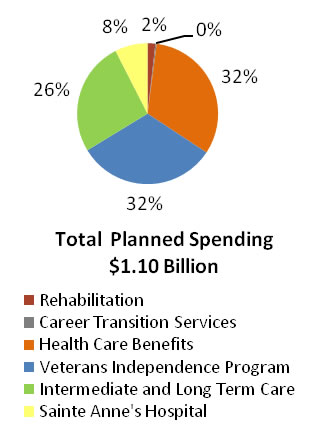
Human Resources (FTEs)
| 2012-13 | 2013-14 | 2014-15 |
|---|---|---|
| 1,775 | 1,700 | 1,586 |
Planned Spending ($ millions)
| 2012-13 | 2013-14 | 2014-15 |
|---|---|---|
| 1,100 | 1,155.7 | 1,153.4 |
| Program Activity Expected Results | Performance Indicators | Targets |
|---|---|---|
| Eligible Veterans are able to remain in their own homes and communities. | The percentage of community dwelling Veterans in receipt of the Veterans Independence Program who are admitted to a long-term care facility during the fiscal year. | < 10% |
| Payments for health care/treatment benefits are processed in a timely and efficient manner. | The percentage of payments processed for health care benefits which are paid directly to service providers. | 70% |
| Eligible Veterans actively participate in the civilian workforce | The percentage of eligible Canadian Forces Veterans who are unemployed. |
The unemployment rate of Canadian Forces Veterans will not exceed that of the Canadian population |
Planning Highlights
Redesigning the Treatment Benefits and Veterans Independence Programs
The Department will redesign the business processes of the Treatment Benefits and Veterans Independence Programs to ensure that Veterans and their families receive more efficient service. To achieve this, VAC will streamline its processes, make better use of technology and support employees with current information and appropriate tools.
Improving communications
VAC will work to improve how Health Care Program information is communicated to Veterans and service providers. The Department will review and update the relevant information available on its website. We will also review all correspondence, including official decision letters, and rewrite these to ensure they are complete and easy to understand.
Strengthening provider relationships
VAC will be working with the Federal Health Care Programs System (FHCPS) contractor to develop a comprehensive strategy and plan to strengthen provider relationships to ensure that communication is ongoing; that issues are being resolved quickly; and that VAC is kept aware of industry changes.
Delegating VIP decision making
VAC will further clarify the roles and responsibilities of client service team managers, case managers and client service agents in making VIP-related decisions in order to better serve Veterans and other individuals receiving VIP benefits.
Improving technology
The Department will increase the use of technology in the delivery of its programs to reduce inefficiencies. Primary areas of focus include tracking and recording information in the Client Service Delivery Network (CSDN) to consolidate information in one location and to enhance program statistical information. VAC will also look to decrease turnaround times by setting up a digital imaging process for many of its VIP-related forms.
Improving rehabilitation services and vocational assistance
VAC will develop new service standards relating to the delivery of rehabilitation services and vocational assistance. This will ensure that staff and contractors have a clear understanding of what is expected and will improve departmental monitoring of these programs.
Policy Renewal
VAC will simplify its existing policies and create new ones that better support decision making by front-line staff. Research-based evidence will be used to support program and policy development.
Strategic Outcome #2 - Canadians remember and demonstrate their recognition of all who served in Canada’s efforts during war, military conflict and peace
Program Activity: Canada Remembers Program
Generations of Canadian Veterans, through their courage, determination and sacrifices, have helped to ensure that Canadians live in a free and peaceful country. Remembering their contributions depends largely on a Canadian population that actively acknowledges Veterans’ achievements and sacrifices through remembrance-based activities.
Remembrance activities are an essential component of ensuring that future generations understand the high cost of freedom and the importance of protecting human rights, freedom and justice around the world.
VAC contributes to ongoing remembrance by:
- leading and supporting ceremonies and events in Canada and abroad that recognize and honour Canada’s war dead and Veterans;
- providing remembrance-based resources (a wide range of learning materials using a variety of media) for Canadian youth and educators and interpreting war memorials in Europe and Canada;
- establishing and leveraging partnerships that extend the reach of Veterans Affairs Canada’s remembrance mandate;
- providing funeral, burial and grave marking assistance in partnership with the Last Post Fund Corporation; and,
- maintaining war graves, Veterans’ graves and memorials in Canada and worldwide in partnership with the Commonwealth War Graves Commission and others.
SO2 Planning Highlights
- Increasing the awareness and participation of Canadians in remembrance activities;
- Bringing remembrance to Canadians, especially youth, through technology and community events;
- Increasing the recognition of Canadian Forces Veterans and ensuring programming reflects how they wish to be recognized;
- Working with the Last Post Fund to achieve greater efficiencies and to decrease administrative expenses;
- Continuing to improve the Partnership Contribution Programs’ business processes to enhance service delivery and to strengthen partnerships; and
- Launching a new learning package on the post-Korean War missions of the Canadian Forces.
Program Activity 2.1 - Canada Remembers Program
Sub Activities:
- Public Education and Awareness
- Ceremonies and Events
- Partnerships and Collaborations
- Memorials and Cemetery Maintenance
- Funeral and Burial Program
Description
Canadian Veterans and those who died in service have made valuable contributions to the development of Canada. Under the authority of P.C. Order 1965-688, this program ensures that Veterans and those who died in service are honoured and the memory of their sacrifices and achievements is preserved.
Canada Remembers activities promote the following outcomes: Canadians are knowledgeable about their efforts; Veterans are publicly recognized for their service; communities and other groups lead remembrance activities; symbols erected to their memory are maintained in perpetuity; and, eligible Veterans receive dignified funerals and burials.
Encouraging pride in our shared military history, celebrating the contributions and acknowledging the sacrifices of those who served, and preserving symbols to mark their courage all contribute to the Government of Canada’s outcome of a vibrant Canadian culture and heritage.
This program is delivered through grants, contributions and operating funds.
PA 2.1 Snapshot
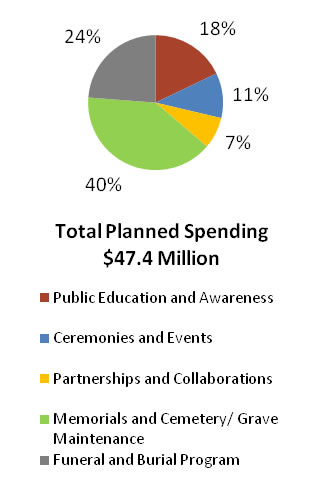
Human Resources (FTEs)
| 2012-13 | 2013-14 | 2014-15 |
|---|---|---|
| 98 | 98 | 98 |
Planned Spending ($ millions)
| 2012-13 | 2013-14 | 2014-15 |
|---|---|---|
| 47.4 | 46.1 | 45.6 |
| Program Activity Expected Results | Performance Indicators | Targets |
|---|---|---|
| Canadian Veterans and those who died in service are honoured and the memory of their achievements and sacrifices is preserved. | The percentage of Canadian Veterans’ overall satisfaction with how VAC delivers its remembrance programs. | 85% |
Planning Highlights
Commemorating Canadian Military Accomplishments
April 9, 2012 marked the 95th anniversary of the Battle of Vimy Ridge and a Canadian delegation led by the Minister of Veterans Affairs and the Governor General of Canada participated in ceremonies held in France. Also in attendance were close to 5,000 Canadian youth. These youth witnessed the courage and perseverance shown by the young Canadians who fought during the Battle of Vimy Ridge. They will form a new generation that will help shape the future of our great country. In Canada, events included ceremonies at the National War Memorial, in Toronto, Vancouver and in many other communities across Canada.
In addition, VAC is planning activities to mark the 70th anniversary of the Dieppe Raid in August 2012, and is exploring ways to commemorate Canadian sacrifices and accomplishments in post-Korea and modern-day peace keeping missions. Looking further ahead, VAC is in the preliminary stages of planning to mark the 60th anniversary of the Korean War Armistice, where more than 500 Canadians lost their lives in the pursuit of peace and democracy.
Centennial of the First World War
Planning is underway to mark the Centennial of the First World War, beginning in 2014 until 2018, in partnership with many domestic and international partners. This commemoration will ensure that those who died in service to Canada are honoured and the memory of their sacrifices and achievements is preserved for all Canadians. As there are no surviving Veterans of the First World War, this commemoration will provide assurance to those Veterans who are still living and to those CF members who are still serving, that Canada recognizes their service and will continue to demonstrate her appreciation no matter how much time passes.
Recognizing modern-day Veterans
Ensuring modern-day Veterans receive the recognition they deserve is a complex and ongoing project of the Department. After learning that approximately half of VAC clients (45% of modern-day Veterans and 58% of traditional Veterans – 2010 National Client Survey) were unaware of the Department’s remembrance programming, VAC provided sessions to CF members on bases across Canada to provide them with information about its Canada Remembers Program. As a result of these sessions, VAC was given considerable feedback about what remembrance means to current Canadian Forces (CF) members and their feeling about how they wish to be recognized. This information will be compiled, analyzed and considered in program development to commemorate modern-day Veterans in ways that are relevant to them. More immediately, VAC will complete and release its Canadian Forces Around the World learning kit to create better awareness among Canadians of the actions of Canadian Forces Veterans, thus ensuring their legacy is protected.
Youth and technology
VAC will continue to apply new and innovative strategies to engage Canadians, especially youth through the use of technology such as the Department’s website, the virtual poppy, remembrance applications (APPS) and Quick Response or QR codes. VAC will also continue to further develop social media tools such as Facebook, YouTube, Twibbon and Twitter.
Recognizing sacrifices
Another planning highlight that will contribute to the realization of honouring the memory of the sacrifices and achievements of Canadian Veterans and those who died in service are plans for the ongoing maintenance and improvements of VAC memorials, cemeteries and gravemarkers, in Canada and overseas. In addition, VAC will continue to work with stakeholders to respond to their priorities and concerns with regard to funeral and burial benefits.
Strategic Outcome #3 - Veteran’s rights to services and benefits that address their needs are considered in an independent and impartial way.
Program Activity: Veterans Ombudsman
The Office of the Veterans Ombudsman (OVO) works to ensure that Veterans and other individuals served by VAC are treated respectfully, according to the Veterans Bill of Rights, and receive the services and benefits they need in a fair and timely manner.
The OVO addresses complaints, emerging issues and systemic problems related to programs and services provided or administered by VAC, and those related to the Veterans Review and Appeal Board.
More broadly, the OVO plays an important role in expanding awareness of Veterans’ needs and the contributions they continue to make to Canadian society when they return to civilian life.
The Veterans Ombudsman has the following mandate:
- Review and address complaints arising from the application of the provisions of the Veterans Bill of Rights;
- Review and address complaints related to programs and services provided or administered by the Department or by third parties on the Department’s behalf, including individual decisions on benefits and services for which there is no right of appeal to the Veterans Review and Appeal Board;
- Identify, research and investigate emerging and existing systemic issues related to the provisions of the Department’s programs and services;
- Review systemic issues related to the Veterans Review and Appeal Board; and
- Provide information and recommendations to the Minister in relation to identified systemic issues.
SO3 Planning Highlights
- Ensuring the fair treatment of Veterans, serving members of the Canadian Forces, and the RCMP, as well as all other individuals served by Veterans Affairs Canada;
- Reviewing and addressing complaints arising from application of the Veterans Bill of Rights, as well as individual decisions on programs and services;
- Facilitating access to VAC programs and services;
- Providing awareness and opportunities for public and Veteran consultations; and
- Enhancing ability to respond to requests through the Access to Information Act and the Privacy Act.
Program Activity 3.1 - Veterans Ombudsman
Description
This program provides Veterans and other individuals (war service Veterans, Veterans and serving members of the Canadian Forces (Regular and Reserve), members and former members of the Royal Canadian Mounted Police, spouses, common-law partners, survivors and primary caregivers, other eligible dependants and family members, other eligible individuals and representatives of the afore-mentioned groups) with the opportunity to request independent reviews of their complaints.
It promotes fair and equitable treatment in accessing the services, benefits and programs from Veterans Affairs Canada. This is accomplished by: providing them with information and referrals to facilitate their access to programs and services; reviewing and addressing complaints arising from the Veterans Bill of Rights and decisions on benefits and services for which there is no right to appeal to the Veterans Review and Appeal Board; and researching and investigating emerging and existing systemic issues related to the provisions of the Department’s programs and services and providing information and recommendations to the Minister in relation to those issues.
This program is delivered through operating funds.
Human Resources (FTEs)
| 2012-13 | 2013-14 | 2014-15 |
|---|---|---|
| 40 | 40 | 40 |
Planned Spending ($ millions)
| 2012-13 | 2013-14 | 2014-15 |
|---|---|---|
| 5.9 | 5.9 | 5.9 |
| Program Activity Expected Results | Performance Indicators | Targets |
|---|---|---|
| Veterans and other clients are aware and have access to Ombudsman services. | The percentage of contacts responded to. | 90% |
| Number of unique visitors/social media ‘hits’. | Same or increased | |
| Veterans/clients, Veterans Affairs Canada, influencers and government decision makers are aware of the issues and recommendations raised by the Ombudsman Office. | Number of appearances to Senate and House of Commons committees on Veterans Affairs/Briefings to Parliamentarians. | 5 |
Planning Highlights
Early intervention
The Office of the Veterans Ombudsman will continue to provide direct assistance through early intervention activities so that complaints, information requests and referrals are resolved in a timely and appropriate manner.
Investigations
The Office of the Veterans Ombudsman will focus on initiating and investigating systemic issues, along with assessing and contributing to the resolution of complex Veterans issues.
Public consultation
By maintaining public consultation initiatives (including web-based approaches, town halls and speaking platforms) aimed at engaging Veterans and other stakeholders, the Office of the Veterans Ombudsman will be better able to identify and inform all Veterans and other individuals on issues of concern and emerging priorities.
To further promote the well-being of all Veterans, the Office of the Veterans Ombudsman will continue to work with the Veterans Ombudsman Advisory Committee.
Program Activity 4.1 – Internal Services
Sub Activities
- Governance and Management Support
- Resource Management Services
- Asset Management Services
Description
Internal Services are groups of related activities and resources that support the needs of programs and other corporate obligations of an organization. These groups are: Management and Oversight Services; Communications Services; Legal Services; Human Resources Management Services; Financial Management Services; Information Management Services; Information Technology Services; Real Property Services; Materiel Services; Acquisition Services; and Travel and Other Administrative Services.
Internal Services include only those activities and resources that apply across an organization and not to those provided specifically to a program.
PA 4.1 Snapshot
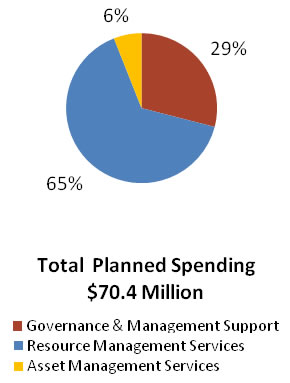
Program Activity: Internal Services
Human Resources (FTEs)
| 2012-13 | 2013-14 | 2014-15 |
|---|---|---|
| 709 | 694 | 641 |
Planned Spending ($ millions)3
| 2012-13 | 2013-14 | 2014-15 |
|---|---|---|
| 70.4 | 65.0 | 65.0 |
Planning Highlights
Delivering internal services
VAC will implement a service delivery model for internal services in order to reduce duplication, eliminate a layer of management, and increase overall efficiency.
The Department will also work with Shared Services Canada (SSC) in response to the recommendations of the Administrative Services Review.
Managing the workforce
VAC will continue to plan its employee needs carefully, to make sure staff resources are aligned with changing client demographics, IT advancements and the simplification of policies and processes. The Department will also ensure that employees have the skills and tools needed to achieve success.
Measuring Performance
VAC will implement a Measuring Program Decisions Compliance Framework in order to improve the effectiveness of its decision making. This framework will cover the appropriateness of program delivery in terms of conformance with relevant laws, authorities, policies and accepted standards of conduct—all measured at both the job and program levels. Trends and issues will be used to further inform policy and program direction.
Privacy Action Plan 2.0
VAC will implement the second phase of its privacy action plan to advance a deeper understanding of privacy and the need to protect information at all levels throughout the Department.
The plan, building on the successes of the first phase, will work to fully integrate privacy protection as part of the overall management framework. Privacy will be reviewed in the following areas:
- Training and awareness;
- Governance;
- Administration and practices;
- Monitoring and evaluation; and
- Reporting and priority identification.
Federal Sustainable Development Strategy
Veterans Affairs Canada is a participant in the Federal Sustainable Development Strategy (FSDS) and contributes to the Greening Government Operations targets through the Internal Services Program Activity. The Department contributes to the following target areas of Theme IV of the FSDS:
- Green Buildings;
- Surplus Electronic and Electrical Equipment;
- Printing Unit Reduction;
- Paper Consumption;
- Green Meetings, and
- Green Procurement.
For additional details on VAC’s Greening Government Operations activities please see Section III – Supplementary Information tables.
